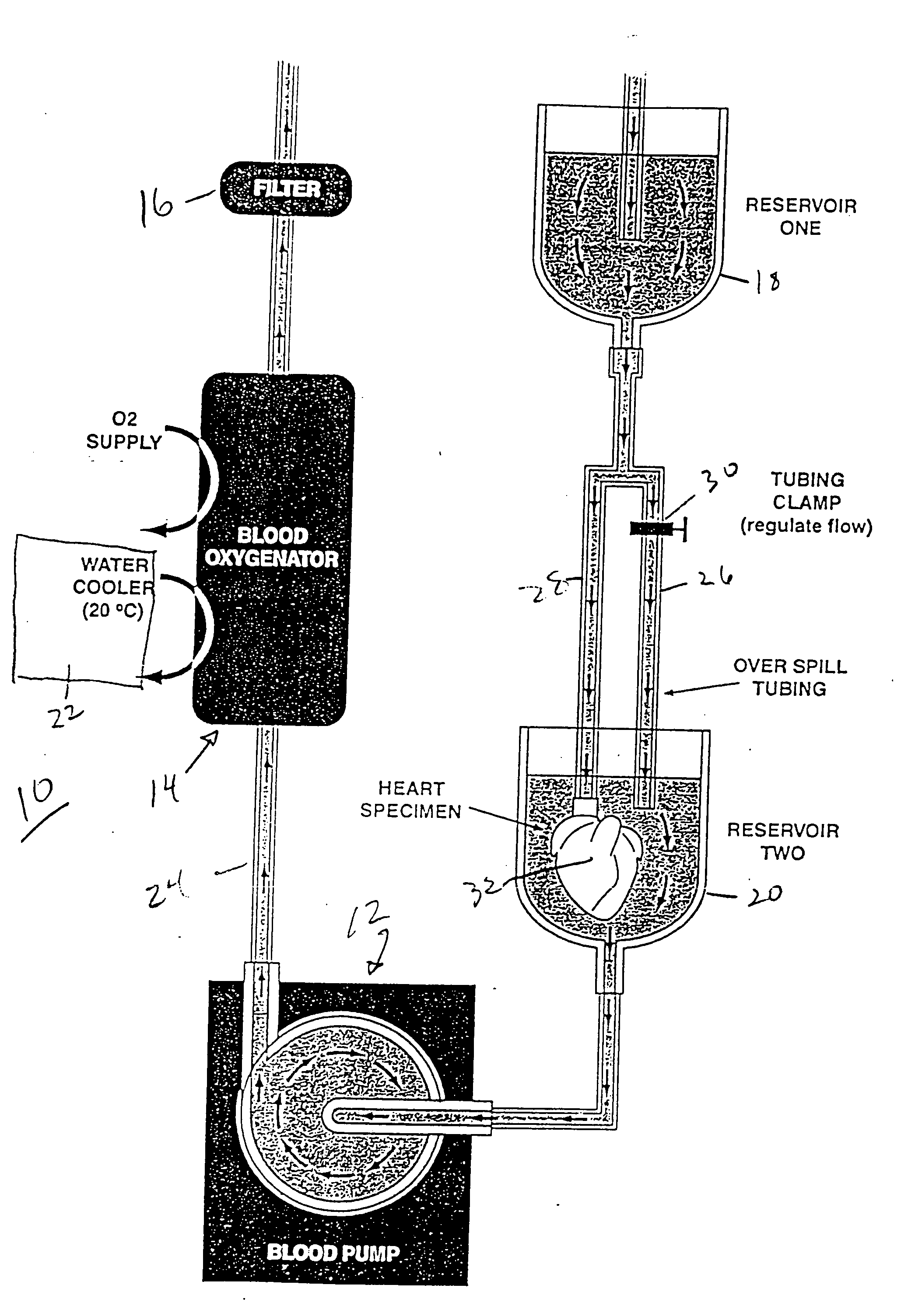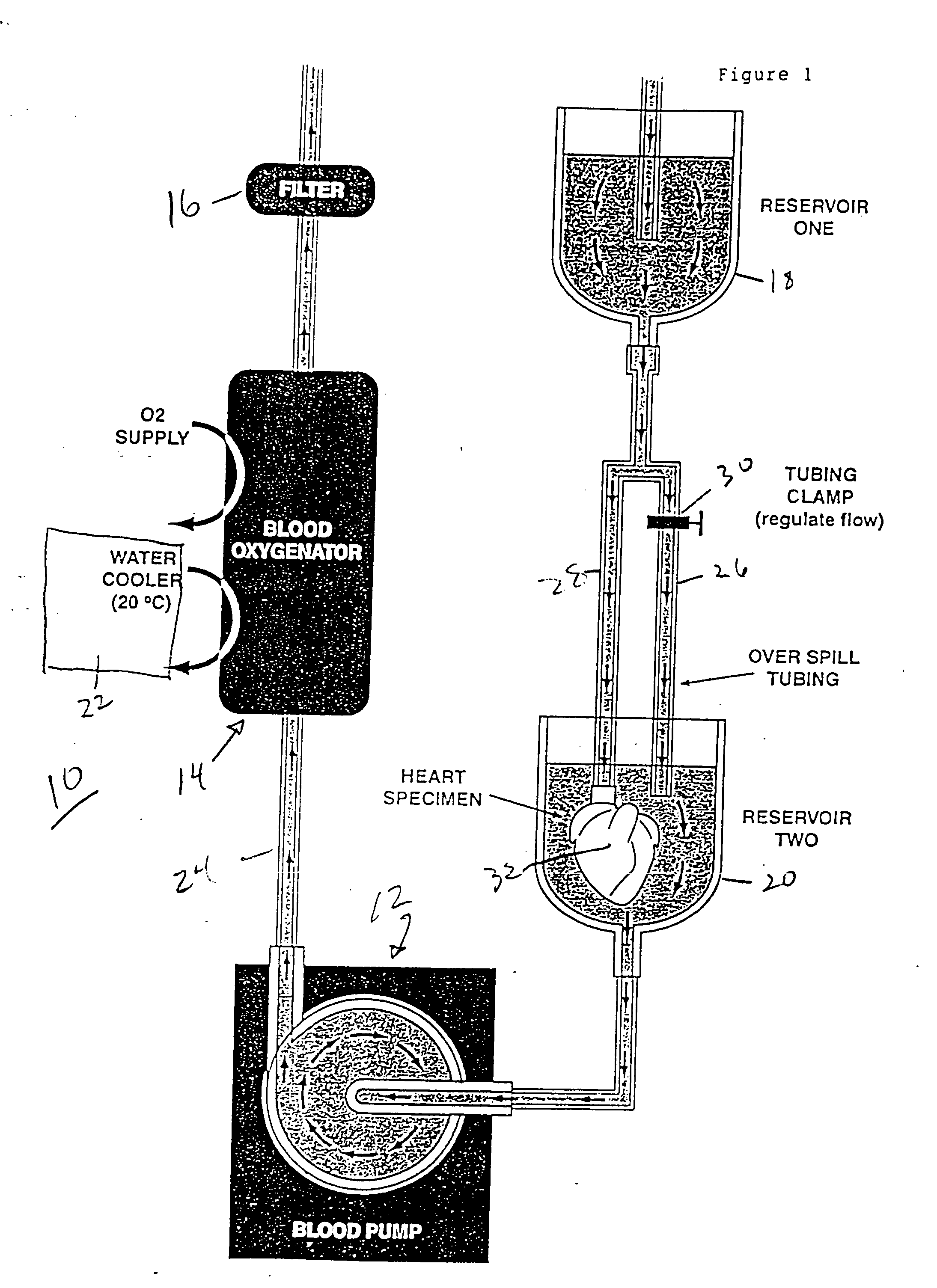Continuous cardiac perfusion preservation with PEG-HB for improved hypothermic storage
a technology preservation time, applied in the field of continuous cardiac perfusion preservation time improvement, can solve the problems of limited promise of cardioplegia-type solutions, irreversible graft damage, and inability to extend the storage time of donor organs, etc., and achieve the effect of prolonging the preservation time of myocardial organs
- Summary
- Abstract
- Description
- Claims
- Application Information
AI Technical Summary
Benefits of technology
Problems solved by technology
Method used
Image
Examples
example 1
[0028] The hearts of 20 anesthetized and ventilated NZW rabbits were harvested after cold cardioplegic arrest. Group I (n=10) hearts were continuously perfused with a normokalemic hypocalcemic bovine PEG-Hb based solution formulation at 20° C. and 30 mmHg of aortic root pressure for 8 hours. Group II (n=10) hearts were identically preserved with a crystalloid solution identical in composition used in Group I hearts, but with deletion of PEG-Hb.
[0029] Twenty adult male New Zealand White rabbits (3 to 3.5 kg) were anesthetized using an intramuscular injection of 50 mg ketamine and 5 mg xylazine per kilogram. Lactated Ringers solution was infused through an intravenous catheter in a marginal ear vein at a rate of 5 to 15 cc / hr. The rabbits were mechanically ventilated using a Servo Animal Ventilator (model #900C, Siemens-Elema, Sweden). Anesthesia was maintained with intravenous ketamine / xylazine in a 1:1 ratio. A median sternotorny followed by a longitudinal pericardial incision was ...
example 2
[0043] The hearts of 9 anesthetized and ventilated NZW rabbits were harvested after cold cardioplegic arrest. Group 1 (n=4) hearts were continuously perfused with PEG-Hb composition of this invention at 20° C. and 30 mm Hg for 8 hours. Group II (n=5) hearts were continuously perfused with crystalloid formulation for 8 hours at 20° C. Cardiac function was measured with a left ventricular balloon at 0, 1, and 2 hours after transfer to a standard crystalloid Langendorff circuit.
[0044] Heart rate was the same for group I and II through the testing period (89.6 vs. 91.1, p=0.57). Developed left ventricular pressure (systolic minus diastolic) at 0.6 cc left ventricular volume was greater in Group I (76.17:t19.2 mm Hg), than in Group II (52.0:t25.21, p=0.021). Maximum dP / dt at 0.6 cc left ventricular volume was greater in Group I (854.4 7:t381.8 mmHg / sec ) than in Group II (485.10:t284.14 mm Hg / sec, p=0.025). Percent water of total ventricular weight was 82.0% for Group I and 81.6% for Gr...
example 3
[0045] The hearts of 25 anesthetized and intubated NZW rabbits were harvested after cold cardioplegic arrest. Group I (n=7) hearts were perfused with a PEG-Hb solution of the claimed composition at 20° C. and 30 mmHg for 24 hours. Group II (n=10) hearts were preserved by cold ischemic storage for 4 hours at 4° C., and Group III (n=8) were tested immediately after harvest. Left ventricular function was measured in the non-working state immediately and 2 hours after transfer to a standard crystalloid Langendorff circuit.
[0046] Developed left ventricular pressure at 0.5cc left ventricular volume was similar in Group I (54.2:1:2.6 mmHg) and Group II (49.1:1:5.4 mmHg,p=0.5) but greater in Group III (69.4:1:5.1 mmHg, p=0.02). Maximum −dP / dt at 0.5 cc left ventricular volume was similar in Group I (−398.1:1:19.0 mmHg / sec), Group II (−354.8:1:49.1 mmHg / sec,p=0.2) and Group III (−456.2:1:44.1 mmHg / sec,p=0.7). Maximum +dP / dt at 0.5 cc left ventricular volume was also similar in Group I (660....
PUM
 Login to View More
Login to View More Abstract
Description
Claims
Application Information
 Login to View More
Login to View More - R&D
- Intellectual Property
- Life Sciences
- Materials
- Tech Scout
- Unparalleled Data Quality
- Higher Quality Content
- 60% Fewer Hallucinations
Browse by: Latest US Patents, China's latest patents, Technical Efficacy Thesaurus, Application Domain, Technology Topic, Popular Technical Reports.
© 2025 PatSnap. All rights reserved.Legal|Privacy policy|Modern Slavery Act Transparency Statement|Sitemap|About US| Contact US: help@patsnap.com



